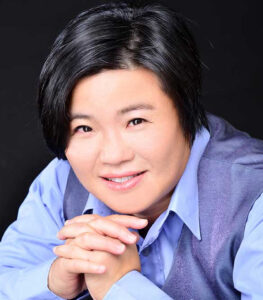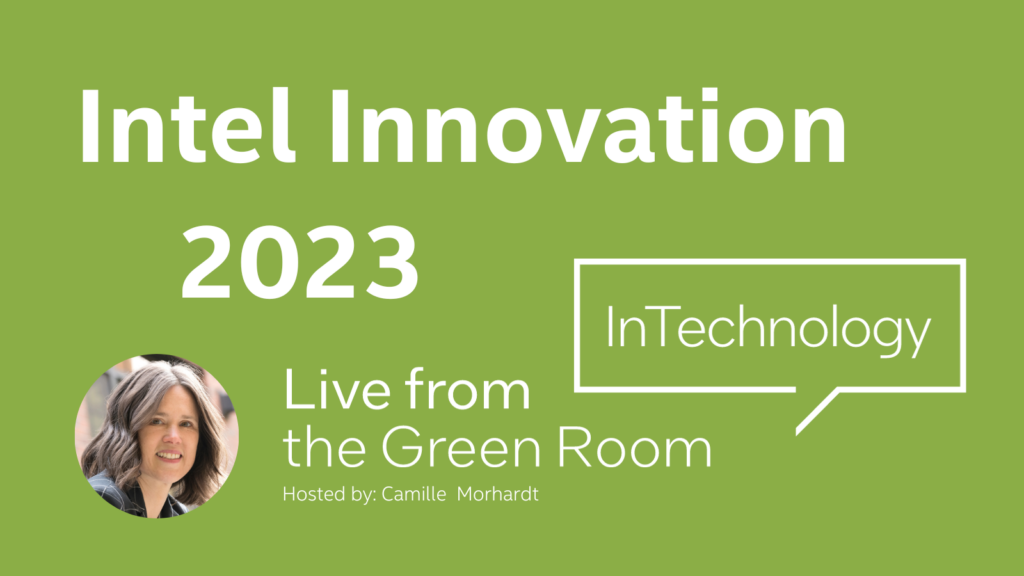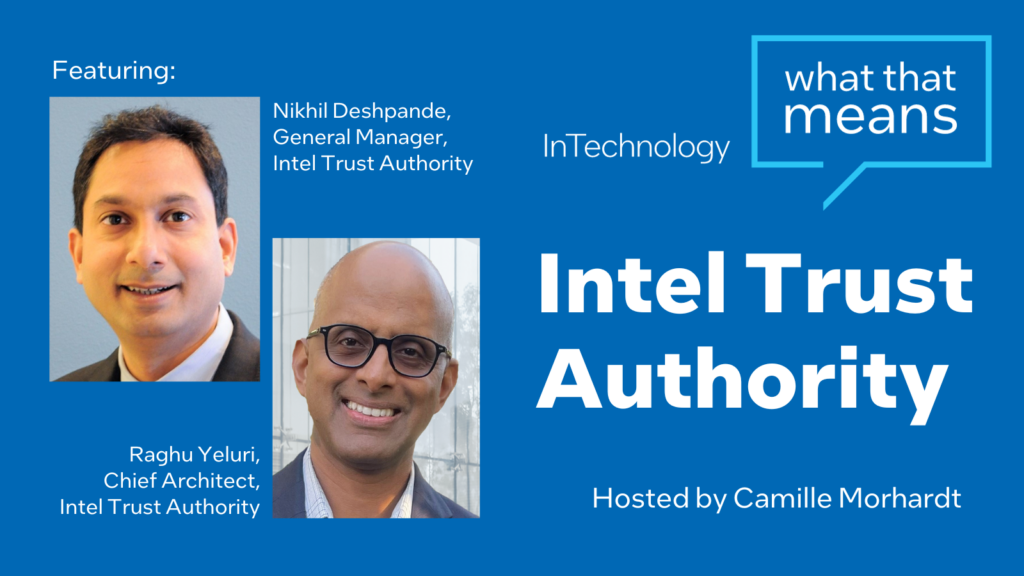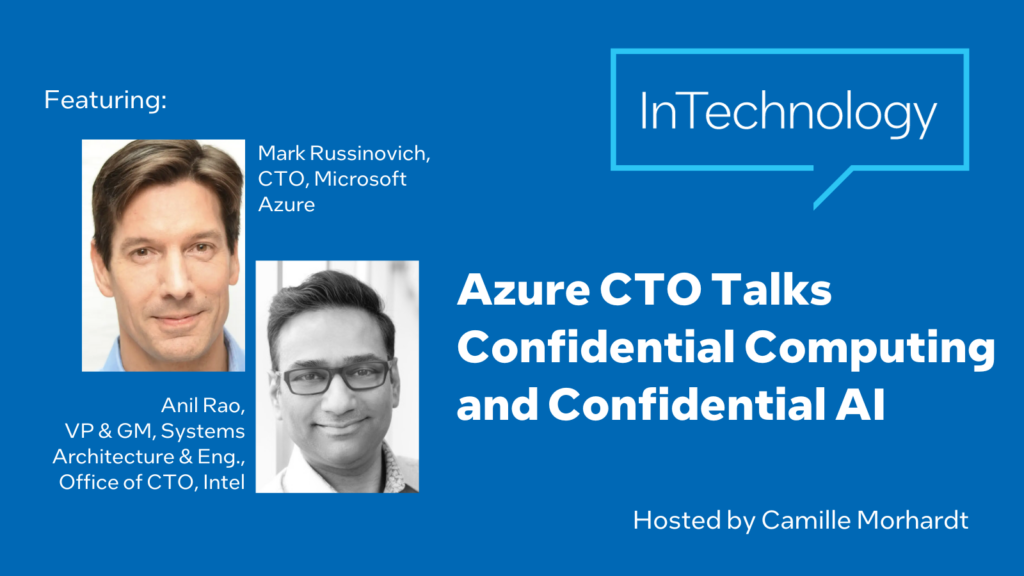Camille Morhardt 00:27 Hi, I’m Camille Morhardt, host of InTechnology podcast, and today I’m going to have a conversation with Joannie Fu about network and edge and the intersectionality of technology and the edge. Joannie Fu is VP of Network and Edge Group at Intel Corporation and she is also got engineering degrees in all kinds of different engineering. Joanie also was recently named among Fast Company’s Top 50 Queer. So welcome to the show. Joannie.
Joannie Fu 00:57 Thank you. Thank you for having me.
Camille Morhardt 00:59 Joannie, I think I met you when I hopped in one of the rideshare vehicles, I guess, at the time, and just said, “Oh, you’re with Intel too? I’m going to same place you are, can I hop in?”, and it was at a Lesbians Who Tech conference and you’re like, “Sure, get in!” And then I found out, you were, you know, kind of an important person, and I was talking to you about it. And you were just so friendly, and genuine and nice. And I’ve liked you ever since. So I’m really happy to have you on the podcast.
Joannie Fu 01:26 Likewise, I really enjoy your passion and your vision in regards to how diversity, technology, innovation all come together. I just remember that was a great experience for us.
Camille Morhardt 01:38 And you were also just a fairly recently recognized among the top 50 on the Queer 50 list in Fast Company. So congrats on that.
Joannie Fu 01:48 Super proud and super humble, I think we need more of our representation within the community out there.
Camille Morhardt 01:54 All right, so I don’t actually know kind of your start in technology, I realized. So I would like to, we’re gonna meander back and forth between technology topics and importance of diversity and inclusion. So I want to start off by asking you how you got involved in technology?
Joannie Fu 02:10 And that’s a great question. Actually, when I was thinking about this idea of intersectionality of humanity of technology, and everything that comes together, it really started with my childhood. I’ve been fascinated by technology and humanity and solving complex problems since then. My father was the very first telecommunication engineer in Taiwan Telecom, which owns all the phone lines in Taiwan. So if you go back and history 1945, 1950, that was when phone lines just started to be installed in Taiwan. So he was one of the groups that was in there, he took me and show how human voices of sound waves was translated into electrons. And then magically, the electrons become the human voices again, at the at the end, with the analog signal transmission over the copper line and later with digital transmission, it was just so amazing. And I just thought, “wow,” that was so cool to see how technology and humanity come together, where you’re connecting people to people, even at that stage.
So for college, though, I went through structural engineering and architecture was my undergrad, and cross interdisciplinary learning, where design and engineering intersects with psychology, society and art form. So I was super interested in the way people interact with man-made environment, and how man-made environment is actually influencing the people’s behavior.
So then, how did I get to Intel? Well, I’ll take out my graduate degree, I joined Intel, first as a Construction Program Manager to build the world’s most complicated factories, which is called fabrication plant, or fabs, as we call it that manufacture the most advanced technology by literally lining up electrons to move, process, store and communicate data on circuits that’s thinner than human hair. So then, when I finished that first project, I became very curious to learn more about semiconductor manufacturing. And I went back to school and took courses in electrical engineering, industrial engineering, manufacturing engineering, and I coupled that with structural engineering and material science background from my architecture studies. That became a foundational intersectionality of technology, and humanity to drive emerging technologies of the future to advance human interests.
So I’ve served on CPU, SOC, chip set, memory, landed the first Silicon Photonics—launched that product; then went to Altera and when Intel Patera, and did FPGA transfer data from TSMC, to Intel, and now to the edge solutions that we’re working on right now to change the world. So it’s just been an amazing journey. And it is about intersectionality.
Camille Morhardt 05:02 So how long have you been at Intel, did you say?
Joannie Fu 05:05 23 years.
Camille Morhardt 05:07 Wow, what a fascinating career. So now you’re in charge of network and edge. Can you take a minute and just define what network and what edge are.
Joannie Fu 05:19 There is no standard taxonomy, or industry wide definition about the edge—depending on who you talk to, to be super honest, and their motivation and perspective, right? But why is it that it’s difficult to define edge, because it is not a singular entity, and there is no singular market, or segment or use case or workflow or application. If you’re looking at the edge, it’s a way to reframe and recast how infrastructure boundaries beyond the data center or the public cloud, known as the “core.”
If you talk to a sports person, they will tell you that the stadium is the edge, if you go and talk to a grocery store, they’ll tell you that the actual cashier is the edge. So it depends on the person and depends on the industry. If I would define this, I would say that the edge is a new old frontier of different infrastructure domains. And it is a growing, growing opportunity. It is predicted that by 2027, more than 70% of data will be generated outside the core, all generated by edge. So to define edge, you need to look at it as it is a data gathering, processing, storing networking and communication data that’s generated between the core—that’s the data center—and the endpoint.
But sometimes you’re here to word “near edge,” or “far edge.” Near edge is looked upon as it is closer to the data center, such as cellphone towers and network gateway; whereas far edge is compute deployed in locations further from the data center, such as shopping mall cars, and factory your smartphone is an edge device that we look at and it is a far edge item in there. Then we further define and qualify when you talk about “intelligent edge,” or “edge compute” is the placement of the resources to actually process and analyze the data at the source, or the point of service delivery that enables actionable insight. A great example of that is facial recognition. You’re putting in sensors and processing power within that camera for the camera to recognize you or recognize whoever it is; that’s the camera coming through and actually come up with executable insights. So when you go to a shopping mall, and you’re trying to try and clothes virtually by using that that is actually an edge application edge computer you’re seeing. So it is a very long answer to a very short question from yo but it is to sum up the edge is everything outside of that data center core.
Camille Morhardt 08:06 Right. And so I can see how networking becomes integrally intertwined with that. So talk a little bit more about that when we have such distributed means of data collection and talk about how we—whoever we is—are deciding where various pieces of data are processed. Rather than shipping them all, I suppose, into the data center, they’re being processed in different places; how’s that orchestration occurring? And is that changing over time?
Joannie Fu 08:36 So right now, there is no standard ecosystem. And everyone is going after this market and trying to define that ecosystem and that standard, but you would see it in terms of industry. So as an example, autonomous driving, there’s already a type of ecosystem development and standard and development kit, and languages that actually goes in and define how autonomous driving could work by placing all the compute into the car, and using LIDAR or very quick data transfers in order for the actual driver to be driving safely, along with the AI that’s within the item. So that is determined by the car industry.
Shopping Mall is another great example where we’re seeing retailers coming together and say, “can we build out, for example, a standard like palette of color, skin color, or eye color or things like our avatar that enables our customers to actually be able to react quickly, and check if they liked the dress or shirts that they’re trying on?” And then the other great example is the fast food restaurant example where we’re using the edge—McDonald’s or Burger King—and you guys are seeing that right now is you can go into a fast food restaurant order very quickly. That’s an edge and it is being standardized.
So what we’re seeing is the segments are being standardized overall, but whoever is able to connect all of that and drive that one platform where it’s seamless within the industry will win this game.
Camille Morhardt 10:15 Okay, so that’s kind of the Holy Grail. So what about how it’s evolving alongside AI? Are various insights being generated closer to the edge that previously could only occur in a data center? Or how you know, or there’s, of course, federated learning, which is, you know, distributed sort of AI or machine learning. And it really hasn’t even been around all that long. So how are those kinds of use cases changing things in AI?
Joannie Fu 10:43 I think I would say that it’s actually they’re complementary. With the intelligence edge, you’re actually accelerating the edge AI, and vice versa. We’re seeing smart classrooms being set up. Now smart classroom may or may not be a new idea for people when we talk about it. But let me throw this up. A smart classroom that has a camera that actually tracks the eye movement of the students when the teacher is speaking, when the teacher is displaying PowerPoints, or texts, or things that is actually teaching the students in the classroom or whether the virtual classroom or in-person classroom; the camera is actually capturing by eye movement and facial expression, whether or not the student is engaged. Is the student learning? Is the student confused? Are they’re actually understanding of that and give real time feedback to the teacher. Whether or not the teacher needs to slow down, the teacher is not as effective or the students is actually not paying attention. If we use that as an example, you can see how AI actually enabled the edge compute. And the edge compute enables the AI use case. And the end result goes back to the intersection of human and technology, why I’m so excited about this topic is that you would actually have a better classroom, and a better learning experience. And you’re giving real time feedback to the teacher to actually become better teachers. And that is so important, Camille, because as AI is coming together, you have to think about new skillsets and new ways that the human being has to interact with AI.
But then let me tell you about the challenge. Challenges, security, ethics, trust, how do you know, if the AI is actually being trustworthy? How is that data being used? How are those insights being used? Is it really equitable across the group? What if it’s a person who is non binary, what if it’s a person who has a darker skin color, with the AI pick up on that and treat it differently? We all know that standardized testing actually doesn’t work well, with inner city kids. We know that that’s been said you have to study it. But if we look at smart classrooms and example I just gave, how does that change the educational value and educational insight that we’re doing? And is it really going to help or create a greater chasm between the haves and have nots?
Camille Morhardt 13:21 Even if you’re up-leveling that or anonymizing it and sort of packaging it as the entire classroom as opposed to individuals within the classroom? You know, what happens then if for the people who decide to bow out of that kind of technology? Are they falling behind? Or do we have good recognition that some people may be interested in that and some people may be running out of the room when they hear about?
Joannie Fu 13:44 Exactly, exactly. Oh, my daughter, when COVID happened it was really interesting as well is that the kids all had you know, virtual classroom right. And there’s a camera and the kids has background in it. Two of the kids were actually told to remove the background, the school then installed blur function for that all the kids have the same background. But I wonder about that, right? Why is it a difference between how a kid has something in the background versus not? Right?
So there is a lot of ramification when you think about using this technology, whether it’s intelligent edge, whether it’s AI, in this new world, and that’s one of the reasons why I’m also super interested in AI ethics and responsible AI things, right? How do we do this? So it makes sense, and then that it doesn’t overpower the humanity in all of us.
Camille Morhardt 14:36 So what are people arguing about other than you gave us a good kind of description of people are arguing over what is the edge to start with? And probably, like you said, a bunch of privacy and ethics considerations. Are people arguing over how to architect the edge?
Joannie Fu 14:54 Yes, actually, not another great question. And when you think about the evolution of edge, I’m going to make a little joke, but it’s almost like the Lion King. It’s literally a circle of life. If you think about the edge as I just defined it, it’s everything outside the cloud. Just as simple as that. It’s everything else I cloud, whether it’s you’re storing the data, you’re processing and you’re computing there, you’re analyzing data or you’re moving the data. If it’s all that, then you can actually think about the 1980s to the 1990s, where the PC was the edge, right? PC outside of the data center. And it’s actually connect different things like that. Whereas if you look at 2000-2010, the smartphones and the machines, where you’re seeing the explosion of the edge, where all connected device, going from social media, all the way through the computer, all that and you look at those numbers, it’s actually scary. In 10 years, from 2001 to 2010, the US mobile users for the smart edge grew from 31 million to 856 million. Ten years.
At that time, all the data goes to cloud, right? And so there is an easier way, if you think about it, there’s a way to standardize, which we have. And there’s a way to update. And there’s a way to oversee everything, because the ecosystem and the dev cloud, and all that has been set for that. It took over 30 years, right? I just talked about 1990 and then 2010. Now we’re in 2020. In this decade, we already seen the whole shift in what needs to happen. So when you think about that, that oversight may not be there anymore and how do we as humans pull together? And that’s where the challenge will be?
Camille Morhardt 16:42 You know, it’s kind of like I don’t know which side of the coin to look at, on the one hand, possibly personal information could remain at the edge kind of in a controlled or private environment—where insights can be generated, and then perhaps then shared with the cloud, as opposed to transmitting raw personal information. On the other hand, do I want whatever camera happens to be installed, you know, on the side of whatever building to be able to process my facial recognition? Because there’s so many different vendors and so many different manufacturers putting out edge equipment. What’s your take on that trade off?
Joannie Fu 17:22 I think that a sort of policy—and this is happening right now, by the way, Camille; EU just pass an AI policy, China’s looking at one ,US government is looking at what it is changing. It is being watched by the government. And the question then is how do you set these regulatory policies without killing the innovation? That’s always that challenge, right? How do we do that, as well. But my point of view is very simple in a way. I think that if we’re thinking about the edge compute, we must not think about these data as permanent data; we must think of this data is in the presence of when my usages needs to happen. And it’s a harder one.
So as an example, let’s say I go to a theme park, you have an app, right? App tells you where you are, you can do a fast pass, it will jump the line, you can make an appointment, where the line is at. It tells you everything. It’s on prem, that is actually an edge application is on premise. But as soon as I walk out of that premise, all that data should be expected to be deleted. That would be the marriage of a perfect, I have to usage at the tip of my hand with this screen. And at the same time, I know that whatever I bought whatever camera or whatever image that is of me, is going to be deleted, so that I actually get my privacy back.
Camille Morhardt 18:50 Well, what if you return to said park multiple times a year? So are people arguing over that? When you cross over the line now it’s okay to sort of regenerate and remember what you liked? Or is that kind of a consumer opt in?
Joannie Fu 19:03 Yeah, that should be an opt-in on your phone. But the memory should be on your phone, or the memory should be on your computer.
Camille Morhardt 19:10 What would you personally kind of worry about as the edge is being sort of orchestrated, and networked? And I’m also going to ask you what you’re personally excited about.
Joannie Fu 19:19 Yeah, so my biggest concern is actually the same as my biggest excitement overall. I think privacy, security and ethics are three, obviously area that everybody’s concerned about. But going back to the theme of humanity. I am concerned about our next generation. I am concerned about our kids. My daughter, I talk to her all the time. There are jobs right now, that doesn’t exist five years ago, right? You’re talking about data scientists, AI big data, large language modelers. So with technology advancement, what kind of skill set do human beings need to have so that we can continue to grow as a human being and actually help?
I know that my daughter doesn’t need to memorize any more the US history. I know my daughter doesn’t have to go into a library and look up in the encyclopedia. She can literally type all that. She doesn’t need to memorize the Pythagorean Theorem. She doesn’t have to memorize any of that. But then what is she learning? Is she learning just using the edge compute to actually help her to get to where she is? I don’t know. If you look at where we have come as a humanity for so many years, we’re solving complex problems with generative AI with all these AI tools, we may get lazy, then what’s going to happen with humanity? And so I think the key is, how do we educate our next generation? How do we ensure that with all these advancements, that there’s a way for them to learn and actually have new skill sets?
Camille Morhardt 20:56 Well—
Joannie Fu 20:56 But then what am I excited about—
Camille Morhardt 20:58 Well, I uh, now I have a question I just want to ask, because the better the edge gets at sort of customizing for its environment or for its human that it’s helping, the more, I guess, fraught, again, with potential issues, because if you’re researching something, but it’s coming to you from a well orchestrated edge, you may be seeing just more and more and more of the kinds of answers that you’ve already been interested in, instead of tapping into like a broader data set that hasn’t been customized to you.
Joannie Fu 21:29 Absolutely. Is that bubble, right?
Camille Morhardt 21:31 Filter Bubble?
Joannie Fu 21:32 Yeah, that big bubble, and you’re living in this bubble, and you’re not thinking or the critical thinking skillset, which is what I always tell my daughter as well is, you need to question the data. And the result in summary, and conclusion, as just a first step in what you’re learning. You don’t know, that can be an opinion, that could be an input. I mean, everything you and I are talking about right now is not industry standard, Camille. Things are shifting as we know. And so to create the critical thinking skillset and the versatility to lead, because leadership doesn’t come from edge AI leadership is still a human skillset. And at the very end of the day, I think decision making and quality database decision making with critical thinking, is the skillset that human beings must develop and must advance.
Camille Morhardt 22:27 Interesting. So and I cut you off, because you’re going to talk about what you’re excited about.
Joannie Fu 22:17 Oh, yeah, no, I’m just I’m just excited about data democratization, right? If you think about it with edge compute, the data and executable insight can happen it with everybody. Right? The knowledge and the information and insight and foresight represents power in human society. In the past when it was cloud or internet, whatever it is back in the you know, 80s and the 90s, where it’s only accessible to a few and to the rich. Now, it’s everywhere. So that knowledge and that insight, where it’s everywhere, it distributes through all of humanity, and that will make the society better and truly improve human lives. So that I’m excited about.
Camille Morhardt 23:04 Well, Joanie FU VP in Intel’s Network and Edge Group, really interesting conversation, You’re so thoughtful about humanity and technology and what it means for the two to come together. So thank you very much for your time.
Joannie Fu 23:35 Yeah, no problem. Hey Camille, can I add one more thing?
Camille Morhardt 23:38 Yes.
Joannie Fu 23:39 Going back to my daughter and career development, I just want to say one very important thing to your audience as well, is when we think about intersectionality, when we think about edge, when we think about technology, it can apply to your personal career, as well. If you heard my career that I talked about, where I leveraged structural engineering, material science, industrial engineering, electrical engineering, and everything, the continuous learning is the key in this new era of edge compute and intelligent edge. That is a very important thing. Being able to learn and connect things together is better than any AI can do.
Camille Morhardt 24:16 I agree. Thank you.
Joannie Fu 24:18 No problem.




